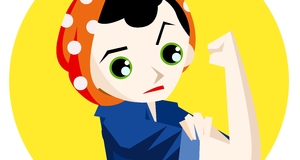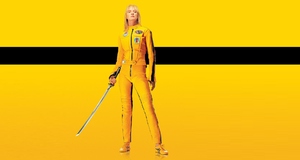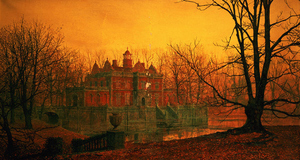The Performance of Femininity in Charlotte Perkins Gilman's Herland and Simone de Beauvior's Second Sex
By
2011, Vol. 3 No. 04 | pg. 1/1
KEYWORDS:
Charlotte Perkins Gilman’s novella Herland explores a separatist feminist utopia. Published in 1915, Herland begins when three men – a womanizer, a Southern gentleman fixated on woman as domestic angels, and a narrator who represents a neutral opinion – stumble upon a land inhabited only by females. This nation, dubbed ‘Herland,’ is a highly developed civilization filled with feminine imagery (every tree bears fruit in this fecund land). A utopia of sorts, it’s a land that values progress, peace, and order above all. As the men adjust to their nascent existence, they grow increasingly ashamed of the patriarchal home they left behind in the United States. But the men eventually adjust to their new world, comparing it to the flawed patriarchy they left behind. In ‘Myth and Reality,’ the ninth chapter of Simone de Beauvior's seminal feminist manifesto The Second Sex, it is posited that women are mythologized in literature and larger society as the ‘Other’ and the antithesis of the normative male. While men are represented as the natural state of humanity, women are characterized as opposite and therefore inferior. Woman is shackled to a prison in which she must deny her true self for the sake of a false femininity. The idea of a “woman,” Beauvoir suggests, is a social construct. At the beginning of the twentieth century, a woman in literature was characterized either as a “bad woman” or a “domestic angel”. She is not a unique human, but rather an ethereal being. She is the “Other” to men’s natural, and for any woman to be the picture of femininity, she must suppress and objectify her own self. Beauvoir rejects this idea, calling for an acknowledgement of identity in the individual female. She implores writers to create fully-developed, round female characters, assuring that “to recognize in woman a human being is not to impoverish man’s experience.” If literature becomes populated with fully realized female characters, than society at large may stop perpetuating the myth of the female as the exotic “other,” and the cycle of femininity as a social construct will vanish, giving women freedom.Herland explores the differences between a patriarchy and matriarchy, the need for a balanced and disexual race, and, particularly, gender performance. The social construct of sexuality is so deeply ingrained in American and other cultures – expectations for what is ‘masculine’ and ‘feminine’ vary globally, but differences between the sexes permeates universally. In the nation of Herland, there is no Other. There is no need for a girl to live her life devoted to femininity because such a concept does not exist. As a social construct, the feminine is an unreachable goal that forces approximately one-half of the human race to enslave herself to her biology, her double chromosome. In Simone de Beavior’s reality, women are confined to what is thought to be nature’s lot. But in Charlotte Perkins Gilman’s utopia, we are bombarded with fascinating questions: what happens when ‘the Other’ becomes the norm? Is this nature or nurture? What would happen if gender was no longer a separation, but uniformity in culture? Would ‘the woman question’ be eliminated, for now ‘woman’ is the answer? What does it mean for the modern state of gender? Herland is an influential work on gender as a social construct and what it means to be ‘womanly’ in a world where a female is not expected to represent an idealized caricature that is forced upon her. By juxtaposing the men from the American patriarchy with women from this native, female utopia gender as a societal construct is exposed. What develops is a race of mothers, warriors, and intellectuals that develop free from sexual stereotypes and commodification. Upon first introduction to the mere idea of Herland, Terry, one of the male protagonists and the resident misogynist, scoffs at the impossibility of a civilization built by women. He echoes the ideas of the Western world at the turn of the century: “They would fight among themselves…for women always do. We mustn't look to find any sort of order and organization." It is true that the citizens of Herland are able-bodied fighters, but they are not weighed down by the petty squabbles that the men expected. Rather, these Amazonian women are skilled warriors, foresters, and hunters. In fact, it is Terry who is the brunt of his warrior-wife’s so-called ‘unfeminine’ aggression when he attempts marital rape. The citizens of Herland have an athletic shape, not thought attractive compared to the delicate yet voluptuous Western ideal. And their athleticism is deemed “unnatural” by the visiting misogynists, yet her muscles are built through organic means. The country of Herland originated when the women in a king’s harem rose up to slay their sexual oppressor. The country was built by warrior women, and then grew into a peaceful nation filled with women strong enough to assert themselves. Gilman is urging women with the still-contemporary message not to suppress their true power and not to submit to the pressures of the patriarchy. By freeing herself and unlocking her untapped physical potential, a woman can achieve true autonomy and control. Physical strength is not the only gender paradigm Gilman reverses. For instance, the women of Herland keep their hair short. This would practically be considered a crime of gender in the male’s native land. Alternatively, the men become ‘feminized’ as they spend more time without a barber: their hair grows long, and they cling to their beards as a symbol of what is supposed to be masculinity. The women become teachers for the males, a shift in what was normally considered a male-dominated field. While males resent what they believe to be their condescending education, the women are inarguably the better teachers in the story. The women of Herland pose many questions about the Western world’s segregation and stratification of gender: it seems that keeping women in a home (“like a slave,” a citizen of Herland suggests) benefits the perpetuation of the patriarchy more than it benefits the woman. By denying women what they are, as Herland depicts, fully capable of, the idea that gender is more than a social performance is internalized in Western women. Gilman depicts astounding differences in her fictional matriarchy juxtaposed to the patriarchies that dominate highly developed nations. The male visitors are Christians, who are adjusted to the worship of a vengeful, masculine god. In contrast, the religion of Herland reveres a “Loving Power,” who is a benevolent mother. The Western God represents what governs the society: males, forceful and unchanging. Herland’s great mother represents the deification of motherhood, a reoccurring symbol throughout the novella. The birthing process is considered spiritual. It is what makes woman mighty. She is responsible for life and, consequently, holds great power. While both make the case for femininity as a social construct, neither Gilman nor Beauvoir refute the existence of the innate differences between the sexes. Both authors agree that the binary between the male and female is important: what would life be without difference? The citizens of Herland encourage a sexual reproduction as opposed to their actual asexual method of propagating the race. While Herland is a separatist novel that shows an idealized, genderless society, it does not advocate purging men from society. Rather, it argues the need to include the Western women who are reduced to a status other than human. However, Gilman’s novel is not without its flaws concerning progress. While Herland concerns itself with the idea of womanhood, it also defines woman as a very specific niche: she’s white, wealthy, and young. One of the biggest criticisms that are thrust upon first-wave feminism is its narrow focus. When the male ambassadors to Herland speak of the women of their country, who are revered as domestic angels, they ignore the millions of women living in poverty, without hired help, who have jobs. The narrator’s initial image of a society of Amazonian women is almost like a sorority house: young, sexually submissive women roaming wild. The ambassadors find an island of women who, while they do not fully live up to his original expectations, are decidedly Aryan and beautiful. Gilman’s illustration of an ideal society is telling of turn-of-the-century feminists. The first-wave of feminism was comprised of women lucky enough to be educated. Sociologically, at the time, it was mainly white, young women from progressive families. This demographic is reflected in Herland, which ignores the plight of minority women. An Aryan race on an island nation (implied to be in the South American hemisphere) feels implausible. The satirical way that the narrator undermines women are burdened with financial need is ironic juxtaposed to Gilman’s subtle, actual racism. From a modern reader’s perspective, it is ironic that while femininity is exposed as a social construct, the implications of race are set in Gilman’s contemporary’s viewpoint. Gilman’s portrayal of feminine sexuality is an entirely constructed concept aimed to please men. Even once the women of Herland marry, they are still depicted as desexualized. Their focus is on motherhood, which is historically viewed as the antithesis of sexuality. They have little interest in sexual relations with each other. In 1915, when Herland was published, homosexually was rarely addressed. Thus, romantic (heterosexual) love is shown as the only plausible kind, and yet the desexualized women still reject that. In fact, social interactions among the female citizens of Herland, too, are left unexplored. While the three male protagonists are shown with unique relationships to one another, even with the unfortunate flaws that round their characters, the woman are shown as automatons focused solely on progress and maternity. There is no description of how women interact with one another in this peaceful land, as no friendships are drawn between them. Even the women who the protagonists take as wives are desexualized and dehumanized; they cannot grasp the concept of coital love as something that is not designed for the creation of children and ultimately the propagating of the species. “They are Making People –- and they made them well,” the narrator describes. While every aspect of society is for the good of the child, it casts Herland with a dry sense of stability. Life in this Utopia, the males consider, is boring. The art of Herland’s theatre, for instance, falls flat without sexual desires, jealousy, stratification, and ambition. Both Beauvoir and Gilman assert that males define females solely from their masculine perspective, and this damages both genders. But yet in a feminist piece such as ‘Herland,’ the male gaze is central: even in a land of their own, the women of Herland are made ‘the Other’. Gilman’s choice to write through a male narrator’s eyes can be interpreted in several ways: while a critic may find it to be a parody of masculine values, another reader may feel that, unfortunately, a male voice is thought to be found more accessible than a female’s. A male protagonist is to be expected: a male’s voice is thought to be the ‘natural’, the ‘neutral’. And, paradoxically, that idea is precisely what Gilman is protesting. Beauvoir urges for fully-developed female characters. While the women warriors are physically strong, emotionally they are lacking. Is this in response to the caricature of women as silly, flighty creatures? One could say that Gilman was intentionally creating the opposite of the typically frivolous female character. But instead she creates a race of super-women who feel inhuman precisely because of their lack of emotions. Why must a female be stoic and logical to a fault to be feminist? Why is she not allowed to have faults or feelings? It is an equally synthetic ideal to depict women as something more flawless than human: all characters in well-written literature should have emotional layers, and yet Gilman only gives that privilege to the males. The performance of femininity permeates our culture since prehistoric times. Sexes have traditionally been segregated. Despite our modern times, filled with co-ed schools and pop idols urging girls to be “whatever they want to be,” the trope of a female performing as a submissive partner still populates our literary world more than the take-charge, leading females. There’s Bella of the popular teen-targeted Twilight, who has no female friends, just devotion to her shimmering vampire boyfriend, whose entire allure exists in his potential to kill her. Public school systems believe that males will not read books concerning female characters and thus students miss out on the opportunity to hear another perspective. An entire gender is ‘otherized’ when told that they are not the natural form. The average woman spends four dollars on a magazine that consists mainly of advertisements for products that will help her conceal her true identity in favor of presenting the ‘ideal women’. This performance of femininity overpowers the drive for autonomy. In Herland, the natives are free from the pressure to conform to the unrealistic ideal of artificial womanhood. Gilman and Beauvoir expose this false construction of what it means it means to be Woman. In a world free from pandering to an ideal of femininity that does not exist, women finally achieve independent success. ReferencesDe Beauvior, Simone. The Second Sex. 1953. New York: Vintage, 1989. Print. Gilman, Charlotte Perkins. Herland. 1915. London: The Women’s Press, 2001. Print. Suggested Reading from Inquiries Journal
Inquiries Journal provides undergraduate and graduate students around the world a platform for the wide dissemination of academic work over a range of core disciplines. Representing the work of students from hundreds of institutions around the globe, Inquiries Journal's large database of academic articles is completely free. Learn more | Blog | Submit Latest in Literature |
















